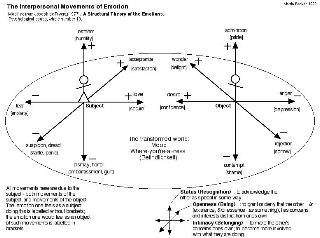Steve,
The diagram is just that, a synoptic look at a long monograph which
I recommend as a good read. Yes, de Rivera was offering a
"structural" - basically structuralist - analysis of the emotions.
The basic idea is that each emotion is a movement, often literal and
if not metaphorical, between two people. Each movement has both a
subject and an object: to put it in very simple terms, I can push
you away in anger, or I can withdraw from you in fear. In both cases
you are the object of the emotion, I am the subject. The movement is
in opposite directions, but in both cases it is along the dimension
of intimacy. Other emotions involve movements along two other
dimensions, which de Rivera names openness and status. The
experience one has as the object of an emotion is different from
ones experience as a subject. I should add that he has conducted
cross-cultural comparisons of emotion.
de Rivera does write about the situatedness of these movements,
though of course even the object of an emotion is in the world for
the person who is a subject. In fact, he argues that each emotion
provides a unique way of understanding a situation. For more of this
I always recommend the article by Hall & Cobey, 'Emotion as the
transformation of world.' So, on this analysis, although an emotion
is an interpersonal movement, and so social, it is *also* an
experience of the situation, and so individual.
I wanted to study moral conflicts, not in the form of what people
say when they are asked to reason about hypothetical moral dilemmas
(a la Kohlberg), but in terms of what people actually do. One clear
component of a real, first-person moral conflict is its
emotionality. How to look at that without reducing it to an
individual subjective experience, chaotic and irrational (the
empiricist approach) - or the result of some intellectual process of
appraisal (the rationalist approach, common among cognitive
psychologists)? What I came to argue was that emotion plays a
central role in conflict: it structures the situation in a way that
is immediate, unreflective, and with a strong sense of conviction.
It is a disclosure, a first way of understanding what has happened,
in action rather than in cognition, and it gives rise to practical
concerns (an impulse to confess, or seek revenge...). This has many
positive aspects, but it also makes it difficult to see the other
person's point of view, or even to recognize that they *have* a
point of view. The conflicts I studied only got resolved when people
talked, even if only to try to convince one another to do what they
considered the right thing, because then they found out that what
they had taken to be 'the facts' were only one interpretation. The
values behind the facts started to become evident. I think many of
us would recognize these characteristics of everyday conflicts.
Martin
On Jul 6, 2010, at 2:33 PM, Steve Gabosch wrote:
Martin, on the interesting chart you modified from de Rivera (1977)
with the 12 pairs of subject/object interpersonal movement of
emotions. It seems to deal with emotions in a decontextualized way
- we don't see the situations that create these responses. Am I
correct in that observation? The pairings it depicts are thought-
provoking, but I don't understand some or most of them. The whole
subject-object structure confuses me. The premise of the chart
that emotions are a way of being engaged in the world, and that
emotions are rational, or have rationality, makes sense - I am ok
with that - but I don't see how this chart is connected to the
world - it seems to detach emotions from their context. I just see
an interesting list of oppositions and groupings of emotions
without explanation. So I seem to be missing something. Could you
explain this chart a little?
On the topic in this thread, I agree with David K that abstraction
and generalization are two different processes. I am not convinced
yet that Vygotsky was always clear on that distinction - he seems
to conflate the two in Ch 5 in some places, for example, but seems
to have found great relief when he solved new aspects of this
question in Ch 6, criticizing the block experiments and their
thinking at the time for some important limitations in this
regard. At the same time, David points out the great pressures
bearing down on psychologists and pedologists in the early 1930's,
greatly distorting that conversation. Lots of puzzles to work out
in that Ch 5 to Ch 6 transition on concept formation theory.
- Steve
On Jul 5, 2010, at 3:30 PM, Martin Packer wrote:
On Jul 5, 2010, at 4:58 PM, Martin Packer wrote:
an emotion is an interpersonal movement.
systematic structure to the emotions, captured in the diagrams
with dimensions of intimacy, status, and openness.
there is a rationality to emotion - emotion is a way of being
engaged and involved in the world.
<Interpersonal movements of
emot.pict>_______________________________________________
xmca mailing list
xmca@weber.ucsd.edu
http://dss.ucsd.edu/mailman/listinfo/xmca
_______________________________________________
xmca mailing list
xmca@weber.ucsd.edu
http://dss.ucsd.edu/mailman/listinfo/xmca
_______________________________________________
xmca mailing list
xmca@weber.ucsd.edu
http://dss.ucsd.edu/mailman/listinfo/xmca
